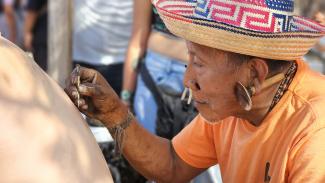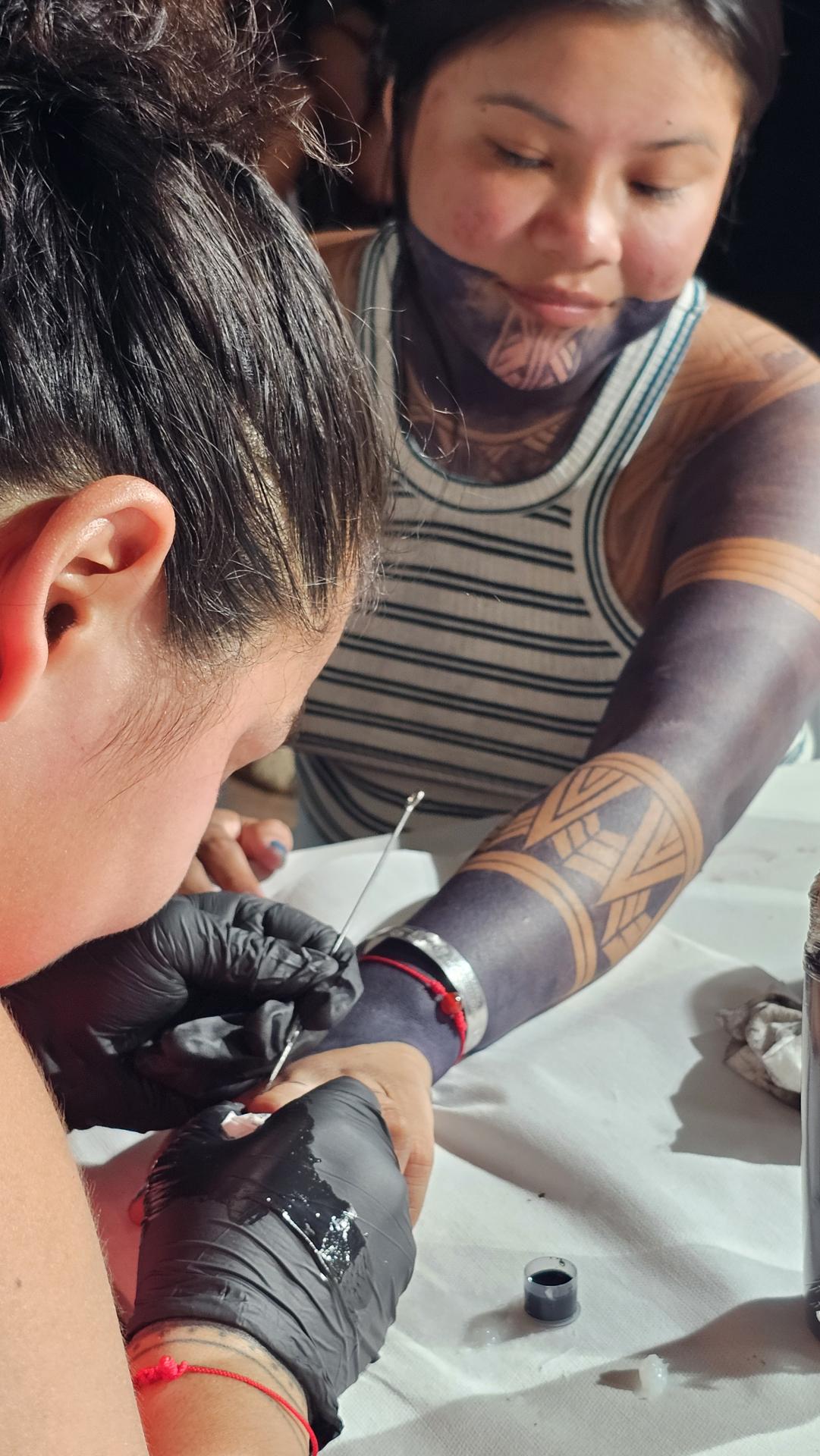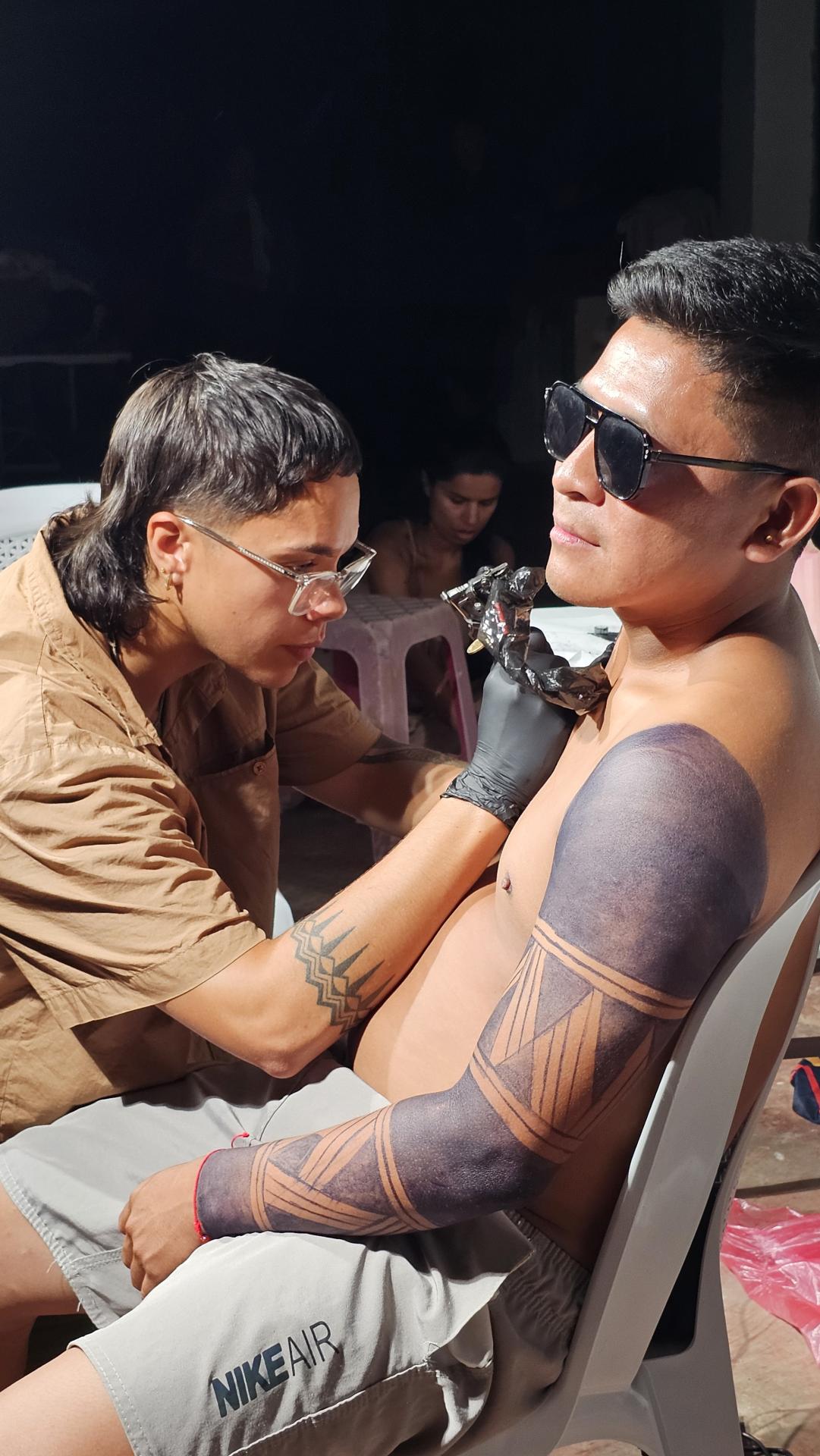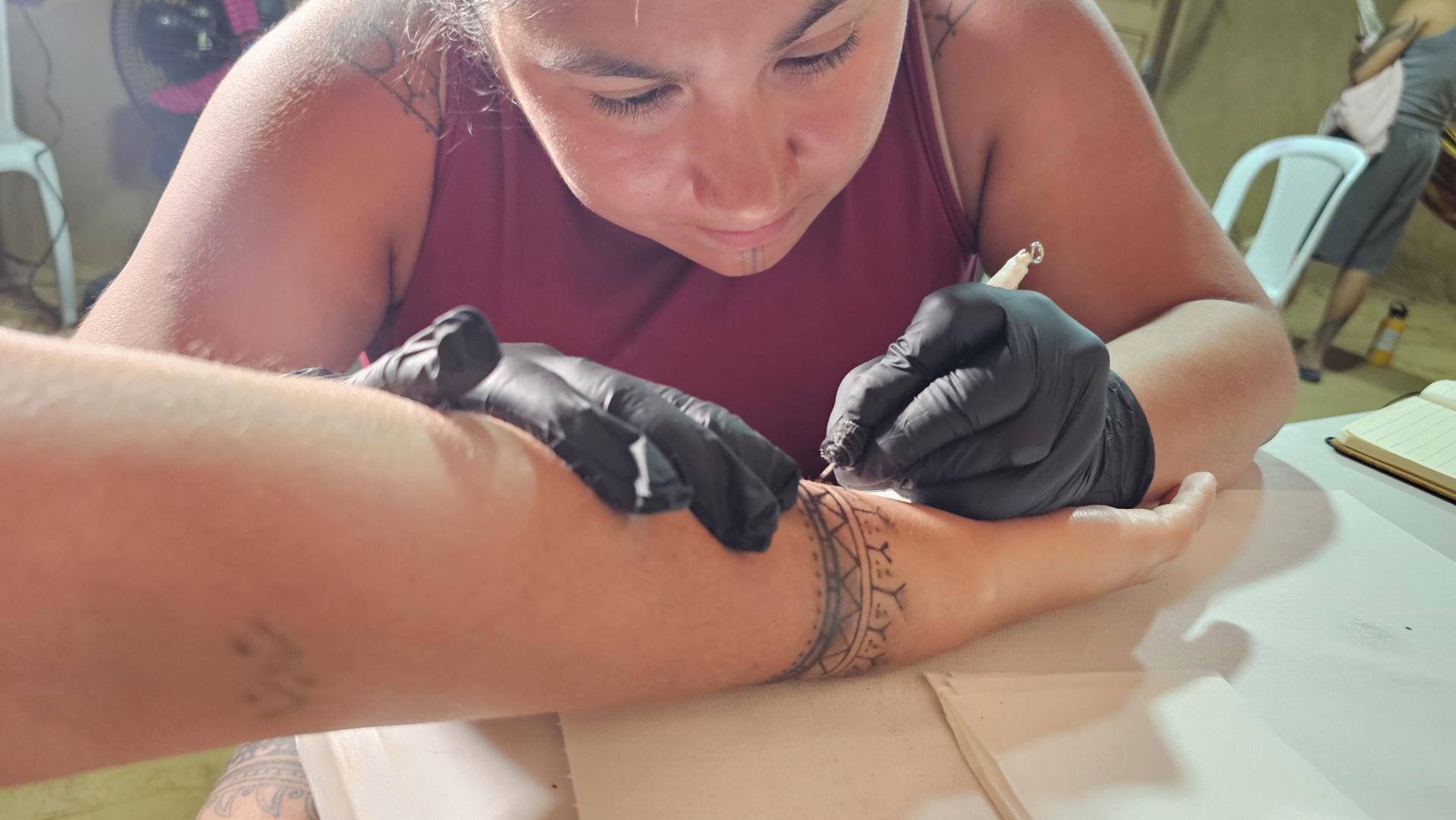
It’s 40 degrees Celsius in the desert of La Guajira, Colombia. The landscape is arid, the trees are sparse, and the soil is sandy, orange, and hot. The most common animal you’ll see is a goat, which is found in most dishes throughout the day. This land is also charged with dreams, as this is how the Wayuu receive their messages and stay connected. The Wayuu are the largest Indigenous community of Colombia, but also make their home in Venezuela. In 2023, the first gathering of Wayuu tattooers took place in La Guajira, the traditional territory of the Wayuu Peoples. Two years later, the First International Gathering of Indigenous Tattoo and Ancestral Markings was hosted in the Wayuu community of Majali from March 21-23, 2025, bringing together both tattooers and non-tattooers to discuss the role that tattooing plays within the Wayuu culture, cosmology, and their journey after death.
This multi-generational gathering was born out of the journey of two Wayuu filmmakers who intended to trace the path of Native tattooers and the stories they had to share. Wayuu attended it from different communities and clans, who created a space where they could remember together, dream together, and reawaken the traditional practice of tattooing, together and on one another. Both older and younger women gave and received tattoos. For some, it would be the beginning of their journey to deepen their connection with this traditional practice of marking their skin. The gathering would hold a space for Wayuu who once held judgments and prejudice against tattoos to embrace marking their skin as an active act of keeping their ways and connection to their clan alive in the afterlife. “I used to be embarrassed to be Wayuu, which hurt me because it meant I was ashamed of who my mother was. I love and respect my mother, so this embarrassment hurt me. The first gathering helped me realize that I came from so much knowledge and such strong people. Elders then
encouraged me that I would grow to be a strong Wayuu,” one young Wayuu participant said. A grandmother added, “We are not used to sharing so much, and this gathering has helped me see and understand the importance of sharing our memories and ways.”

Kunaq Tahbone (Inupiaq) tattooing the hands of Yesibeth, a young Emberá woman, via the hand poke technique.
Traditionally, younger people weren’t allowed to ask questions to the Elders, and the Elders didn’t allow youth around when they were talking. Knowing this was a common experience shared by many Wayuu, hearing an Elder say that she now sees the necessity and importance of sharing her memories and ways was powerful. The gathering that created a space for grandmothers to share memories
and express the desire to keep sharing with the younger generations was a sign that intergenerational transformation was happening before our eyes. It was also a space for urban Wayuu who grew up outside of their community to come home and reconnect with their identity with pride; a space where tears were shed and laughter would echo while memories, stories, names, and images were resurrected.
By the end, the participants knew that fueling this momentum would require the support and solidarity of other Indigenous communities who had faced the same challenges of reawakening the practice of marking their skin.

Fern Ngatai (Māori) tattooing Tumi, a young Matis man.
Participants from the Matis, Inuit, Emberá, Maori, Nasa, and Kichwa Peoples came together to share the journeys undertaken by their communities to reawaken the practice of tattooing and the meaning and impact it has had on reawakening these elements of their Peoples’ ways. Each member shared the meaning of tattooing in their respective communities, describing its role within their cultural context and the efforts made to reawaken or strengthen the art. Discussions were held about how the Wayuu wanted to navigate this awakening of their ancestral practice. Among the questions considered were whether they would only tattoo Wayuu and other Indigenous Peoples, or if they
would open the possibility of tattooing non-Indigenous people—and if so, whether this could open the doors to cultural appropriation.

Kunaq Tahbone (Inupiaq) tattooing the arm of Paloma Abregu.
For the Wayuu, the asho’ojush (a tattoo of one’s clan’s symbol using cactus spine and charcoal) is important because it will help them connect with their clan and allow them access to the waters in the afterlife; it is a bridge that will connect them to life and community. During the 1980s and 1990s when many Wayuu children were forcibly taken from their families and homes and placed in new adoptive homes around Colombia, these babies’ and children’s first tattoos were a marking so mothers could later find their children. The Emberá shared their cultural practice of temporary tattooing with plant dyes, explaining that the markings change depending on what stage of life or practice
they are involved in; they use the temporary tattoos to tell their story on their skin.

Michael Guetio Cobo (Nasa) tattooing the arm of Binan, a Matis Elder.
The Matis community from Brazil were very special guests at this gathering, because their community has had the most recent experience of involuntary contact. The Matis who participated traveled with an Elder medicine man to share stories of their Peoples’ experiences in keeping the ritual practice of tattooing alive. The medicine man said he was 16 the first time he saw a white man, only 50 years ago. His Peoples were tormented by the diseases that the white people brought to their communities, which killed nearly everyone. With only 80 Matis people surviving, the younger generations migrated to the cities. The Matis Elders saw the tradition of celebrations where young men would get their facial tattoos and piercings coming to an end, and were surprised when the very same youth who had gone to the cities came back and asked for their tattoos to recognize their first rites of passage. These stories of coming home to one’s territory, land, community, and traditions were held tightly by all ears and hearts in attendance. The echo of the medicine man’s story—that the younger generations were on the right path to revive tattooing as an active part of their traditional practice—was poignant.
“A few years ago, I started with the idea of doing traditional tattoos and helping young people learn about the symbolism of the Nasa People
through tattooing. Tattooing has always been a way of seeing the world in my life,” said Michael Guetio Cobo (Nasa), a tattooer from Colombia. “When I met two people who also wanted to rescue and strengthen tattooing among the Wayuu, I began to pursue this process with more enthusiasm. Jonatan and David [co-organizers of the gathering] told me about this process. They wanted to bring together a group of Indigenous tattoo artists from around the world, and, well, the day happened. It was magical to see how we felt united in different languages and techniques; it was the first time we all spoke the same language, united by our art. This group felt like a big family of wild people from all over the world, and this convening taught me that the struggle to preserve our cultures, origins, and who we are is enormous. Tattooing and our different ways of thinking help us continue to be Indigenous Peoples, no matter where we are. Tattooing will continue, and we Indigenous Peoples will continue to exist.” Kunaq Tahbone, an Inupiaq tattooer from Nome, Alaska, shared, “It was an amazing experience to attend the tattoo gathering. There were amazing people there, and I feel even closer to our Indigenous kin in South America. The people and communities were so welcoming and made it feel like home. I’ll remember this time and keep the memories in my heart. The connections have been made.”
A small family was created at this gathering through the sharing of each Peoples’ ways, joy, stories of resistance, laughter, and moments of
vulnerability. Spaces like these, where peer-to-peer solidarity creates fertile ground to seed efforts and movements within Indigenous communities to deepen and expand the repatriation of our ways, are critical for the survival of our cultures.
--Paloma Abregu (Quechua Chanka) has been working within the Indigenous rights and reclamation movement in Peru for over 10 years through Saphichay.
Top photo: Binan Shapu (Matis) tattooing a local person.
